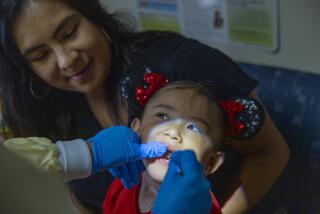Dr. Detective
- Share via
It was a dark and stormy night, the kind on which oral bacteria multiply like mosquitoes in a swamp. The shrill ring of the phone cut through the blackness like a laser drill through tooth decay. “Hello?” Dr. Di Agnostic mumbled into the receiver. She heard a hoarse whisper. “Ya gotta help me, Doc,” it pleaded. “I can’t chew, I can barely talk, and my head is pounding like a Louisiana brass band.”
She’d heard it before, and it wasn’t good news. The symptoms clicked like a well-aligned bite. “It sounds like a jaw joint disorder,” the dentist said with a sigh. “Take two ibuprofen, ice it and come see me in the morning.”
*
Many people think of dentists as tooth technicians. It’s true dentists wouldn’t be doing their job if they didn’t examine your mouth for signs of dental decay and gum recession. But there’s a lot more to dentistry than just filling cavities.
Your mouth opens a unique window to your body, revealing a host of diseases and symptoms--if you know what to look for. A dentist must be a shrewd detective to decipher and diagnose everything from toothpaste allergies to the earliest signs of AIDS.
Frankie the Fist’s tongue and inner cheeks were splotched red and white as a candy cane.
“Is it serious, Doc?” he asked.
“It’s time for you to get a new job,” Dr. Di Agnostic informed him. “You’re suffering from a criminal amount of stress.”
One look in your mouth can tell your dentist more than you would expect. There’s the usual fare: how often you floss and whether you drink lots of coffee or bite your cheeks. But it can also reveal some surprising information that you might not be aware of.
For example, your dentist will know whether you brush too hard, grind your teeth, clench your jaw, experience digestive problems, get frequent sore throats, have allergies or are prone to bad breath.
Like a good detective, a dentist also keeps an eye peeled for anything suspicious. For example, an estimated 30,300 Americans will have oral cancer diagnosed in 1998; 8,000 of those will die of the disease. Oral cancer can affect the lip, tongue, mouth or throat, especially in people who use tobacco or drink alcohol. By catching a sore in its precancerous stage, your dentist could save your life.
Dr. Di Agnostic knew the girl’s upper teeth were trouble as soon as she saw them. The enamel lining of their inner surfaces had vanished like doughnuts in the office on a Monday morning. She cocked her head toward the door and met the patient’s parents in the hall.
“The signs are unmistakable,” she said gently. “I’m afraid your daughter is bulimic.”
In addition to detecting bulimia, dentists frequently are the first clinicians to identify physical abuse, particularly in children. Common symptoms of trauma to the face include broken teeth, a swollen tongue and puffy, reddened inner cheeks.
Dentists also search for clues to serious diseases that first reveal themselves in the mouth. The last time you sat in the dental chair, did your dentist wrap the end of your tongue in cotton gauze and gently pull it out of your mouth? If so, congratulate yourself on choosing a good dentist. He or she was checking the side of your tongue for subtle white stripes, or hairy leukoplakia, one of the first visible signs of HIV infection. Other signals, like tiny red blisters along the inner cheeks and roof of the mouth--an indication of Kaposi’s sarcoma--can also confirm this diagnosis.
(BEGIN TEXT OF INFOBOX / INFOGRAPHIC)
‘Slippery Suspects
Want to learn more about what a dentist looks for during an oral exam? Tighten the strap on your Sherlock Holmes hat, whip out your magnifying glass and investigate the following mystery. Match the symptoms with the culprit disease or condition.
CLUES
1. Swollen, bleeding gums that don’t respond to flossing.
2. Burning sensation in tongue and metallic taste.
3. A persistent red or white patch, lump or sore that bleeds easily and does not heal.
4. Decreased saliva and dry eyes.
5. Toothache after root canal, but no sign of abscess or cracked tooth.
6. Cracked lip corners that don’t heal and removable white patches in mouth.
7. Gums growing over the teeth.
8. Reappearing oral ulcers.
9. Enamel missing from inside of the upper teeth.
10. Teeth erosion.
11. Bite marks, irritated gums and cheek bites.
12. Inability to open mouth completely, pain when chewing, intense headache or earache.
13. Red and white splotches over tongue and inner cheeks that worsen with stress.
14. Enlarged tonsils and swollen uvula.
POSSIBLE CAUSE
Anemia or vitamin deficiency
Sjogrens’ syndrome
Oral fungus
Food allergy
Temporomandibular (TMJ) or jaw joint disorder
Lichen planus
Drug side effect
Oral cancer
Bulimia
Leukemia
Nightly tooth-grinding
Injured jaw nerve
Chronic snoring
Stomach acid backup (reflux)
See below to discover how astute a dental detective you are.
ANSWERS
1. Leukemia
2. Anemia or vitamin deficiency
3. Oral cancer
4. Sjogrens’ syndrome
5. Injured jaw nerve
6. Oral fungus
7. Drug side effect
8. Food allergy
9. Bulimia
10. Stomach acid backup (reflux)
11. Nightly tooth-grinding
12. Temporomandibular (TMJ) or jaw joint disorder
13. Lichen planus
14. Chronic snoring
*
Dr. Glenn T. Clark is director of the UCLA Orofacial Pain and Oral Medicine Faculty Practice.
More to Read
Sign up for Essential California
The most important California stories and recommendations in your inbox every morning.
You may occasionally receive promotional content from the Los Angeles Times.













